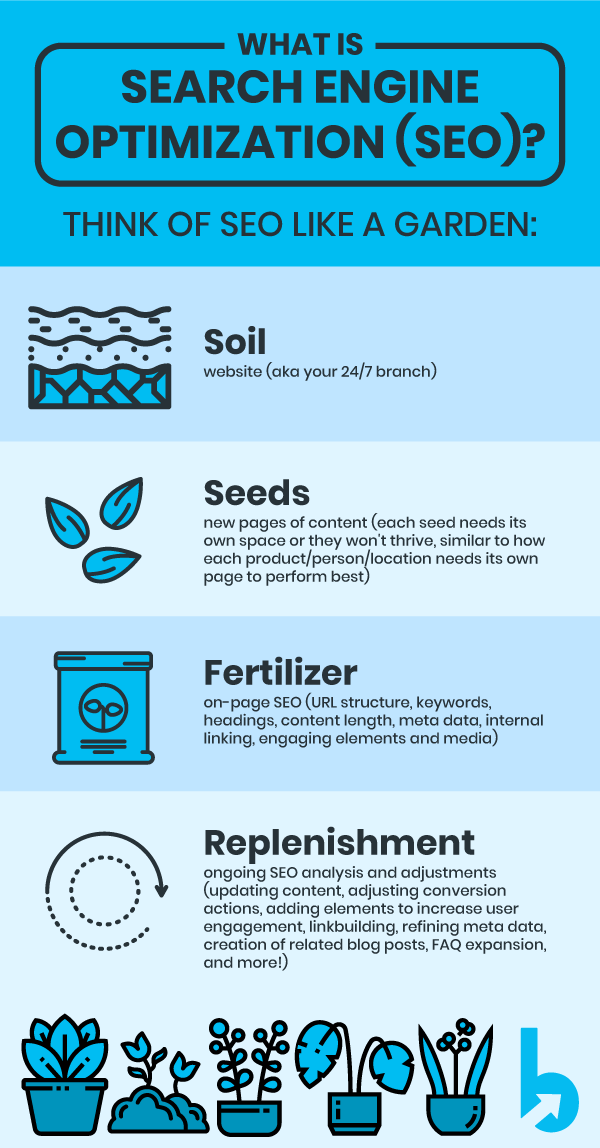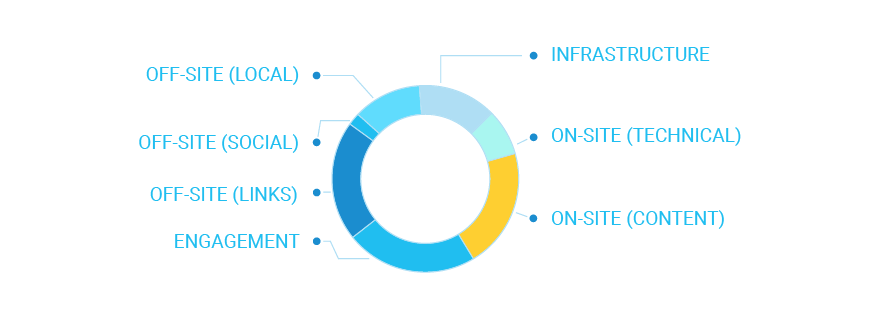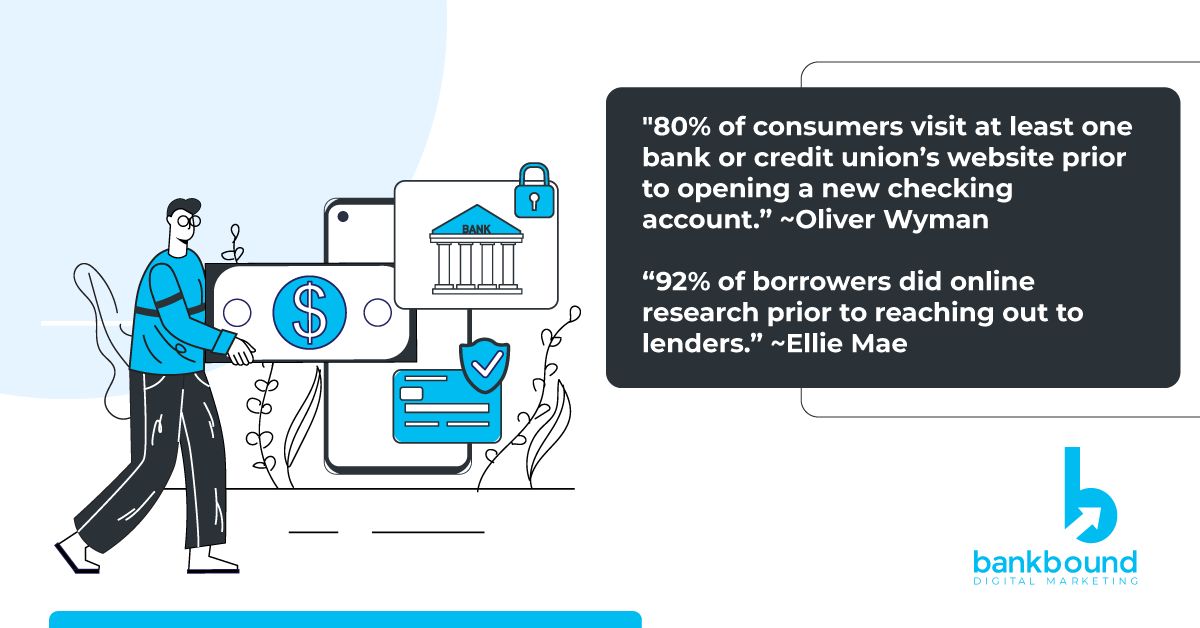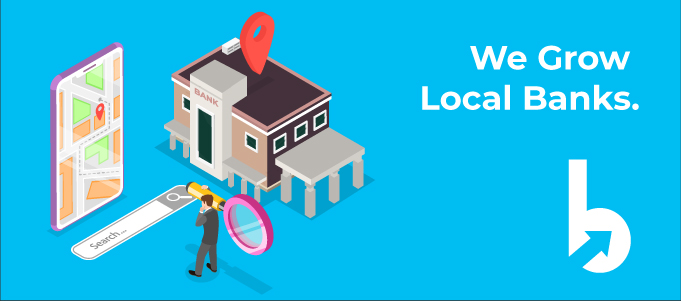Why SEO Services are Important for Banks, Credit Unions, and Financial Institutions
In today’s digital world, people turn to Google first when searching for financial services. If your bank or credit union isn’t ranking at the top, you’re losing potential customers to competitors. That’s where BankBound’s SEO Strategies and Services come in! We help optimize your website by:
- Attracting More Local Customers – Rank higher for searches like “best credit union near me” and bring in more qualified leads.
- Building Trust & Credibility – A top-ranking website makes your institution look more reliable and authoritative.
- Optimizing for Mobile & Voice Search – Ensure customers can easily find your services whether they’re on their phone or using voice search.
- Generating More Leads for Loans & Accounts – Get found for high-intent searches like “best mortgage rates” or “low-interest auto loans.”
- Lowering Marketing Costs – Unlike paid ads, SEO keeps working for you 24/7, bringing in long-term results without ongoing ad spend.
Want to grow your bank, credit union, or financial institution online? Let’s make it happen with expert SEO strategies!
Want people to find your website when searching online for financial solutions and advice? Search engine optimization (SEO) increases website visibility, traffic, and leads. SEO takes time, but results are exponential.
Page Contents
- What is search engine optimization (SEO)?
- How can SEO benefit my financial institution?
- Why partner with BankBound on SEO?
- Top 3 SEO Mistakes Bank Websites Make
What is SEO?
SEO is the ongoing process of moving your website ahead of competitors when target prospects search Google for relevant products or information. And implementing SEO strategies for banks, credit unions, and financial services and institutions will help your site achieve those goals.
Gardening can be a helpful analogy for describing search engine optimization:

Most Common Questions Financial Marketers Ask About SEO
Covered in this video:
-
-
-
-
- What is SEO?
- What are the benefits of SEO for my financial institution?
- How does SEO work?
- How much does SEO cost?
- How do we measure SEO success?
- Should we wait on SEO until the website is redesigned?
- Can’t we do SEO ourselves without an agency?
-
-
-
How Does SEO Work?
When prospects in your geographic area search Google for your financial products and services, Google uses hundreds of factors to determine how relevant your website is versus your competitors–and whether it should appear at the top of a prospect’s Google search results.
How Much Does SEO Cost?
SEO pricing is based on a number of variables, including:
- Personnel required
- Hours required
- Software required
Industry research has shown the average SEO plan costs between $2,000 to $5,000 per month (source: Ahrefs).
Contact us for a custom quote to see what it would cost to partner with BankBound on SEO for your financial institution.
How Important Is It To Appear At The Top Of Google Results?
According to BrightLocal, 68% of online experiences begin with a search engine. While appearing at the top of Google is a strong leading indicator, an effective SEO strategy should ultimately be focused on traffic and leads.
Every day there are people in your target market who are searching Google for the products and services you have to offer. In fact, according to Semrush data, the search volume for “banks near me” is approximately 30.6K per month in the U.S. alone, and 57.5K per month globally. Appearing at the top of Google will support business growth for your bank or for competitors who appear ahead of you (both local or digital).
Should We Hold Off On SEO Until Our Website Is Redesigned?
Not likely. SEO is what ensures your new website will be a successful marketing engine instead of an online banking login page for existing customers.
Prior to the redesign, we want to make sure that analytics tracking and goals are configured for benchmark before/after data, an ideal sitemap/hierarchy is established, target keywords are identified, optimized copy and meta data are created to support target keywords (and approved by both marketing and compliance of course), low quality/redundant pages are consolidated, and much more.
During to the redesign, we want to make sure that analytics tracking and goals are reconfigured, an ideal sitemap/hierarchy is built, optimized copy and meta data are migrated properly, and all range of technical best practices are implemented into the new site (other meta data, internal links, navigation and hierarchy, sitemaps, redirects, H1 tags, and more).
After the redesign, we want to see how Google reacts to the new site, making technical optimization as needed to internal links, copy, meta data, etc. In addition to ongoing monthly optimization opportunities we find through monitoring site health and Google visibility, we’ll want to continue adding more content each month into the blog to accelerate results and continually demonstrate EAT with Google (expertise, authority, trust).
What About Paid Ads?
SEO and pay per click ads (PPC) are complimentary but work differently. PPC ads provide immediate results but require a small click charge for every visitor, whereas SEO results build up gradually but offer exponential growth opportunity.
What Are The Benefits of SEO for My Financial Institution?
- “80% of consumers visit at least one bank or credit union’s website prior to opening a new checking account.” (source: Oliver Wyman)
- “92% of borrowers did online research prior to reaching out to lenders.” (source: Ellie Mae)

Does My Website Need Ongoing SEO?
Without ongoing SEO, organic visibility, engagement, and leads would continually decrease over time. Instead of finding your financial institution, target prospects would increasingly find your competitors.
Is SEO Important for Rural Banks?
While you may have the only brick and mortar bank in a particular market, digital banks and regional banks are still actively targeting your customers and prospects online.
How Does SEO Support Our Bank's Marketing Goals?
- acquire new deposits, loans, and business banking relationships
- increase brand awareness and engagement
- improve website performance (aka your 24/7 branch)
Why Partner With BankBound for SEO?
Whether you already have an SEO strategy in place or are looking to create one from the ground up, BankBound exists to grow financial institutions and specializes in search engine optimization. Our specialized focus has allowed us to maintain a “world-class” net promoter score of 74 from the financial institutions we serve.

Can't We Do SEO In-House Without An Agency?
SEO is a complex and evolving marketing channel that would require your team to have the following expertise:
- Data analytics
- Google platforms (Google Tag Manager, Google Analytics, Google Search Console, Google Business Profile)
- Website design and development
- User experience
- Conversion optimization
- Technical SEO
- Graphic design
- Copywriting
Additionally, your team would need the following tools:
- Competitor analysis software (intelligence)
- Website data analytics software (performance)
- Website scanning software (health)
- Graphic design software (creative)
- Project management software (efficiency)
- Reputation management software (reviews)
- Stock photography subscription (imagery)
What SEO Work Does BankBound Provide?
We provide a long list of deliverables for any banks that partner with us on SEO, most of which fall under technical or creative services. Ultimately, what you’re getting is the ongoing development and promotion of your 24/7 branch office (website). Our primary objective from all the various monthly deliverables is to continually increase online visibility, engagement, and leads for your bank.
Our strategies always include the foundational best practices of search engine optimization along with an emphasis on high-quality content. With these best practices as our foundation, the specific deliverables for your bank will be tailored to the needs of your website and internet presence.
Included Components of BankBound’s SEO Services:
- On-Site SEO, Off-Site SEO, Technical SEO
- Local SEO – Google Business Profile (Google Maps), Bing Places for Business, Yelp, and other local listings
- Site Crawl and Audit Analysis
- Sitemap Creation and Organization
- SEO Keyword Research and Optimization
- Website CMS Management
- Link Building – internal and external
- Content Creation – product pages, location pages, people pages, blog posts
- And much more!
What SEO Results Should We Expect?
BankBound clients typically see 20% increase in organic website visibility, traffic, and leads after an initial year of SEO. Whether it’s credit union SEO, community bank SEO, or local SEO for financial services and institutions of all kinds, we often see incredible results with the strategies we implement.
But BankBound Isn't Local To Our Bank?
We may not be immediately available to meet up for coffee like your local agency, but we can offer shared intelligence from working with 100+ financial institutions in local markets across the country. Our team is more than just familiar with compliant marketing of banking products- it’s all we do.
What If We're Already Doing SEO But Not Seeing Results?
BankBound can provide an analysis of your existing SEO strategy to provide actionable insights for improving your on-site and off-site SEO. We’ll ensure our SEO banking services and strategies are tailored to your needs.
Unlike other internet marketing companies, our agency works exclusively with community banks and financial institutions. Since banking is our one and only core focus, this allows us to truly become an extension of your team and understand the business needs of your financial institution better than other agencies.
Have questions or want help with an SEO strategy for your FI? Let’s have a conversation!
Have questions or want help with an SEO strategy for your FI? Let’s have a conversation!
Top 3 SEO Mistakes Bank Websites Make
We found these issues to be the most commonly missed opportunities for FIs.
Your bank website has a sleek new design that’s now also mobile-friendly; huge win! A shiny new site that passes Google’s Mobile-Friendly Test should surely provide your bank with a boost in organic visibility, traffic, and leads right?
Not exactly. A redesign of your FI’s website doesn’t always improve results.
Unfortunately, there is still a huge disconnect between website design and search engine optimization best practices. Creatives may have a lot of expertise in crafting a beautiful design for your bank’s website, but it’s often the case that SEO is an afterthought. This is truly a shame, since prospects are not likely to find your bank’s lovely site ahead of your competitors if your site doesn’t play nice with search engines.
While user experience should be the top priority for your financial services website, there are ample ways to effectively integrate UX and SEO together.
The following are the most common SEO mistakes we’ve found across the myriad of bank and credit union websites we’ve reviewed.
1. Location Pages
Your branch network may not play the same role it once did since the explosion of mobile banking adoption. However, each physical branch location is an enormous asset to your financial institution’s online presence. Far too often we see bank and credit union websites using a single page to list all their branch locations, or worse yet a dynamic map widget. Instead, create individual pages for each branch to ensure your website is receiving visibility for online searches related to banking in the states, counties, cities, and towns you serve. Individual location pages make a great introduction to your bank or credit union for people in these locations who are searching online for the products or services you offer.

2. Thin Content
It’s quite rare that we find a bank website that includes more than a paragraph or two for each page. More often, we see banks limiting the content of their website pages in an effort to “streamline” the user experience. However, since 9/10 people want to research online prior to opening an account or applying for a loan, it’s imperative that your pages answer all the questions a prospect might have and also demonstrate why your FI is the best option.
You’ve heard it before; content is king. This rings true both for search engines where the average word length for first page results in Google is nearly 2,000 words. This may sound completely unnecessary or even detrimental, but study after study has actually confirmed that longer content is shared more often, ranks better in search engines, receives more social media shares, and converts better. It’s also worth mentioning that borrowed/syndicated content may be fine for sharing on social media channels to build engagement, but to be found in Google your content must be original.
Wondering how you might lengthen your product page copy? An easy way to lengthen content on product pages is to include frequently asked questions. It’s also important to keep in mind that users who are unfamiliar with your brand often don’t enter the website through your homepage; including unique information on each product page about the bank, your service areas, your expertise, etc. is important to make a positive first impression and will help extend the length of your content.

3. Localization
Local financial institutions take great pride in being a true part of the communities they serve. Unfortunately, many financial websites don’t localize their website for search engines or visitors. It’s much easier to rank well locally where there is less competition, so make sure your site works your geographic service areas into the page meta data, content headings, visuals, and copy of each page.
From a user perspective, incorporating local photos, videos, testimonials, supported charities, memberships, and content is a key differentiator and trust builder for local FIs. We frequently see banks silo their local commitment and activities into a single page for “community investment”. Not too many visitors are likely entering your website by way of the community investment page (or taking the time to find it), but that doesn’t mean they don’t care about this information. Instead, banks and credit unions should be tapping their designers and creative agencies to work these local trust symbols throughout the website to maximize their visibility and value. Our local SEO for banks, credit unions, and various financial services will be tailored to your needs.

Final Thoughts on SEO for Bank Websites
While these three SEO issues often represent the highest online growth opportunities for financial institutions, there’s just a little more to it than that. Effective SEO for banks and credit unions incorporates a long list of on-page and off-page factors.
Gone are the days of simple SEO tweaks and tricks that allow websites to instantly dominate search results. Instead, Google uses a complex algorithm that includes hundreds of ranking factors to determine which website pages show up first in SERPS (search engine results pages). Those factors have varying degrees of importance and change constantly, so SEO is a long-term digital marketing strategy that is always evolving. That doesn’t mean your bank should skip out on SEO altogether! Rather, the sooner you can address these three common mistakes and implement a comprehensive search engine optimization strategy the better. Learn more about our SEO services for banks, credit unions, and financial services and institutions today!
Ready to leverage SEO to grow your FI? Let’s have a conversation!
Ready to leverage SEO to grow your FI? Let’s have a conversation!
Talk With a BankBound Strategist
Related Resources
Yes, your bank needs to blog. Here’s why.
If your bank doesn't yet have a content marketing strategy that leverages a blog, this post is for you (or your boss). You've likely heard a lot of buzz about the power of inbound marketing, but is it really worth all the effort?